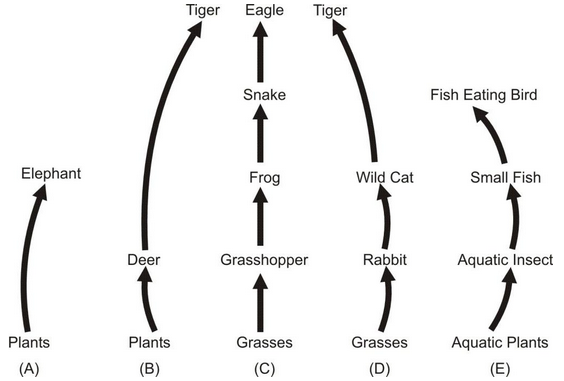Food Chain
Our Environment of Class 10
Food Chain Definition
- The chain of organisms which involves the transfer of energy from one trophic level to the next trophic level is called a food chain.
- The flow of food or energy in an ecosystem is called a food chain. Those organisms which join with the food chain are termed as Trophic levels.
- Usually, there are four trophic levels present in the ecosystem because the level of energy decreases during the flow of energy from one trophic level to another trophic level.
- First trophic level [T1] - Producers
- Second trophic level [T2] - Primary consumers
- Third trophic level [T3] - Secondary consumers
- Fourth trophic level [T4] - Top consumers
| Table of Content |
The flow of energy occurs in an ecosystem from the first trophic level to the fourth trophic level in the food chain, There are five trophic levels also found in a highly complex ecosystem in which tertiary consumers are present in between the secondary consumers and top consumers, then fifth trophic level (T5) formed by the top consumers.

Food Chain Examples
A food chain represents a single directional transfer of energy. For example:
Food Chain in a forest
In this food chain, the grass is the producer organism that uses sunlight energy to prepare food like carbohydrates by the process of photosynthesis. This grass is then consumed by a herbivore like deer. And the deer is consumed by a carnivore like lion.

Food chain in grassland
In this food chain, grass is the producer. The insects (herbivores) are the primary consumer, the frog (small carnivore) and snakes are the secondary consumers whereas the bird (top carnivore or large carnivore) is the tertiary consumer.

Grass → Insects → Frog → Snake → Birds
(Producer) (Herbivore) (Carnivore) (Carnivore)(Top carnivoreor
Large carnivore)
Food chain in a pond
The food chain operates in the aquatic ecosystem (water ecosystem) like a pond, lake, or sea (ocean).

In this aquatic food chain, algae is the producer. The scorpion is the primary consumer, small fish is the secondary consumer. Swan is the tertiary consumer.
Types of Food Chain
There are three types of food chains which are found in nature.
- Predator food chain
- Parasitic food chain
- Saprophytic food chain
Predator food chain extends from producers through herbivores to carnivores, parasitic food chain starts from producers but ends with parasites and saprophytic food chain starts with decomposers. Producers are autotrophic organisms which synthesize organic food from simple inorganic raw material through photosynthesis by utilizing solar energy. A part of food synthesized by the producers is used in their body building, while the rest is utilized in providing energy for various life activities.
- Some common predator food chains are given below:
- Vegetation → Grasshoppers → Shrew → Hawk
- Vegetation → Rabbit → Wolf →Tiger
- Vegetation → Frog → Snake → Peacock
- Plant → Rat → Snake → Hawk.
Aquatic food chains
- Phytoplanktons→ Zooplanktons → Small crustacians→ Predator insect → Small fish → Large fish → Crocodile
- Phytoplanktons→ Zooplanktons → Small fish → Large fish → Shark
- Phytoplanktons→ Zooplanktons → Fish → Crane → Hawk.
Length of Food Chain
In different ecosystems, different food chains may have two, three, four or maximum five trophic levels. Such food chains in different ecosystems are depicted in figure given below. Accordingly, a food chain may end at the (i) Herbivore (primary consumer) level, (ii) Primary carnivore (secondary consumer) level, (iii) Secondary carnivore (tertiary consumer) level or (iv) Tertiary carnivore (quaternary consumer) level.

Food chains in nature. (A) To-step food chain in forest, (B) Three-step food chain in a forest, (C) Five-step food chain in a grassland, (D) Four-step food chain in grassland, and (E) Four-step food chain in a pond.
Frequently Asked Question (FAQs)
Q1. What are 5 facts about food chains?
Ans. Below are the 5 facts about food chain:
- The food chain is known as the transfer of energy from one species to another.
- All living things always need energy for health and growth.
- In a food chain, some living things create energy (producers), and some use the energy (consumers).
- Plants are energy producers as they make their food (using sunlight, soil, and other elements).
- Animals are consumers because they have to eat other animals and plants.
Q2. Why is the food chain important?
Ans. Food chains are important because they always show the complex relationships in ecosystems. They can show how each organism depends on another for survival. Food chains also show what happens when a problem occurs and a producer or consumer is lost. Entire communities can collapse.
Q3. What is Food Chain?
Ans. A food chain is a straight sequence of organisms where nutrients and energy are transferred from one organism to another. This usually occurs when one organism consumes another organism. It starts with the producer organism, follows the chain and ends with the decomposer organism.
Q4. How food chain maintains balance?
Ans. In the food chain, an animal only passes on about 10 percent of the energy it takes in. The rest is used up in maintaining your body or moving, or escapes as heat. The amount of energy available decreases at each trophic level, and each level supports fewer individuals than the previous one.














